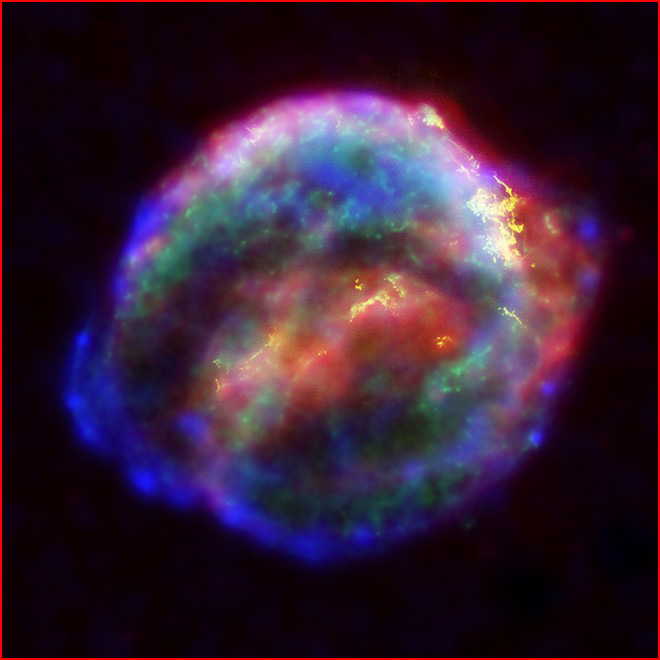
home •
about •
essential guide •
picture of the day •
thunderblogs •
news •
multimedia •
predictions •
products •
get involved •
contact
picture of the day archive subject index
Credit: Kepler's SNR from Chandra, Hubble, and Spitzer, R. Sankrit and W. Blair (JHU) et al., ESA, NASA
Nov 03, 2006
Kepler Supernova RemnantFour hundred years ago, before the invention of the telescope, astronomers were amazed by the appearance of a new star.
It soon dimmed to invisibility, but they noted its location in the sky. Later astronomers, with the aid of telescopes, found at the location of the new star a nebulous cloud of glowing gas (image above). The developing theory of nuclear-powered stars led them to believe the cloud was a spherical shell of gas blown away by an exploding star.
With the discovery that such glowing clouds and their central stars were composed entirely of plasma, a few astronomers realized that electrical forces had to be taken into account. The invention of more powerful telescopes (yellow is the visible light image) and of telescopes that could "see" in x-ray (green and blue images) and infrared (red image) light confirmed the electrical nature of these clouds.
An isolated star that explodes would be expected to produce a spherical cloud of gas. Instead, the cloud is plasma, and it reveals plasma's characteristic feature of organizing itself into a network of electric current filaments (notice especially the yellow and green areas). Furthermore, the cloud is not spherical but shows a distinct bipolar shape, somewhat reminiscent of the form of a brain seen from above. This axis through the nebula and the central star is the path of the Birkeland current that supplies the power to energize the system.
And that energy is expended in more than the visible light that reveals the filaments: Around the periphery of the cloud, on the surface of the plasma sheath that mediates the internal electrical field with the field outside, can be seen bright spots of x-ray emission (blue). This is where currents in the sheath flow between high voltage differentials and, as in a dentist's x-ray machine, accelerate the current-carrying particles to x-ray energies. We see these x-ray spots primarily at the edge of the sheath because that is where we are looking into the currents, where the x-rays are beamed in our direction.
Instead of being the result of a mechanical explosion, the nebula is the result of a sudden increase in the current that powers the central star, a stellar electrical surge. The sheath (which surrounds every star and is normally invisible) has been pushed into the "glow" discharge state; the increased current is pulling matter from the star and from the surrounding space into the filaments that compose that current; and all of it is being heated electrically. Such a surge would have had a sudden onset and an exponential decline--just like a lightning bolt. The new star that 17th Century astronomers saw flaring up in their sky was a stellar thunderbolt. What we see is the declining aftermath.
___________________________________________________________________________Please visit our Forum
The Electric Sky and The Electric Universe available now!

|
|

|
EXECUTIVE EDITORS:
David Talbott, Wallace Thornhill
MANAGING EDITORS:
Steve Smith, Mel Acheson
CONTRIBUTING EDITORS: Dwardu Cardona, Ev Cochrane,
C.J. Ransom, Don Scott, Rens van der Sluijs, Ian Tresman
WEBMASTER: Brian Talbott
Copyright 2006: thunderbolts.info
![]()
home •
thunderblogs •
forum •
picture of the day •
resources •
team •
updates •
contact us

